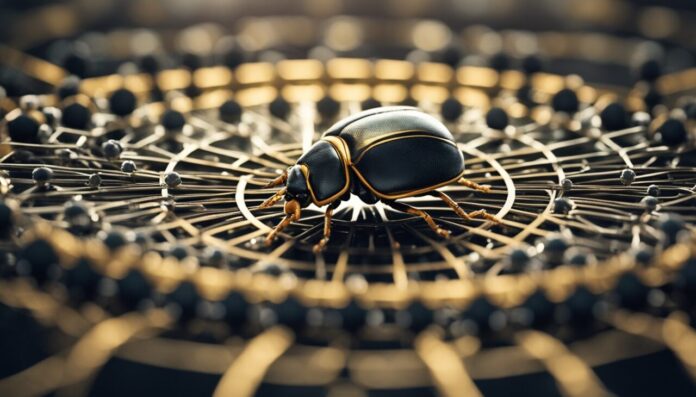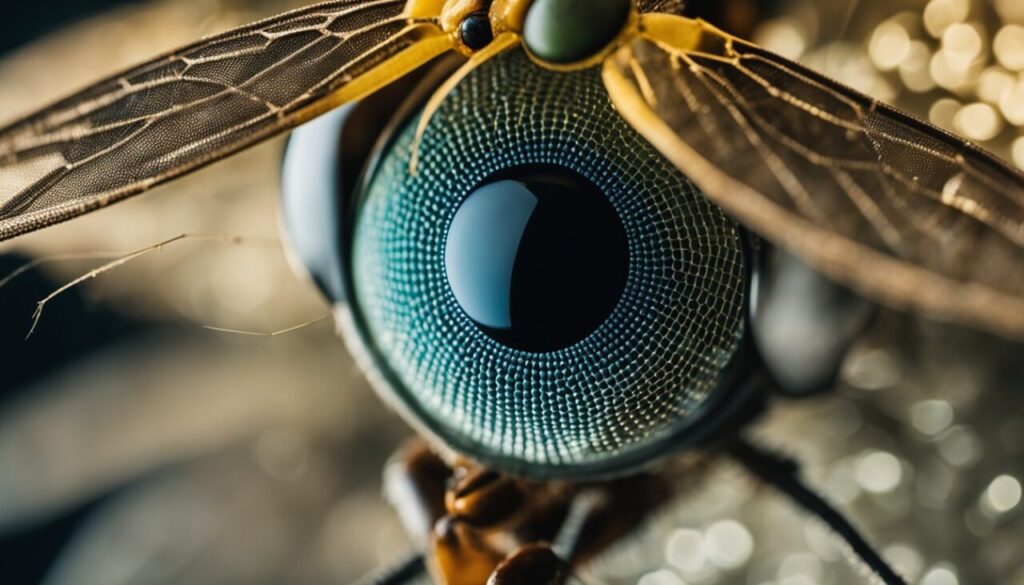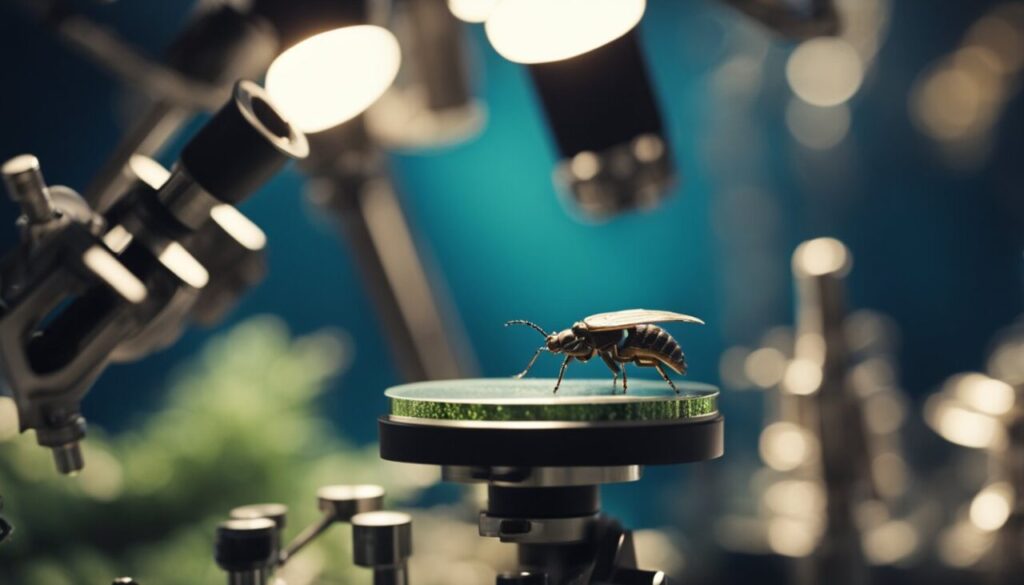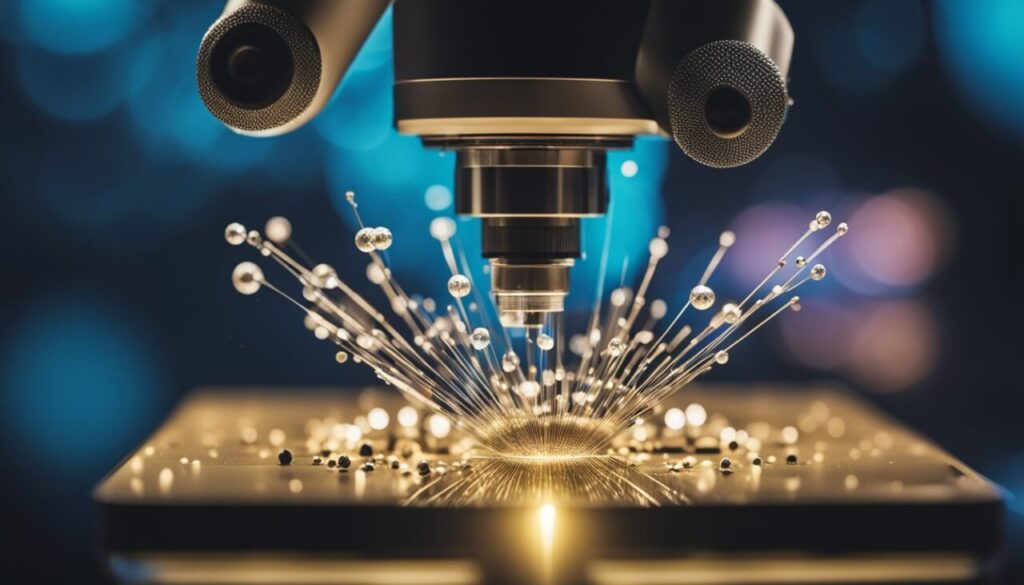
Short answer – NO – as far as we know, even the tiniest bug with the best eyes can not see atoms.
This is because atoms are so small that they do not reflect any light.
Namely, atoms are smaller than the wavelength of visible light, so they do not interact with visible light in a way that would allow them to be seen.
So the answer is obviously simple – insects or tiny bugs cannot see atoms.
Nonetheless, here at CuriousMatrix.com, we like our explanations a little bit longer and more complicated.
So, let’s dive in.
First, let’s explore the sight of different organisms on Earth!
Living Beings on Earth and Their Vision Capabilities

| Rank | Organism | Notable Visual Acuity Traits | Smallest Size Seen (mm) |
| 1 | Dragonflies | Remarkable compound eyes with a wide field of view, high-speed vision | ~0.02 mm |
| 2 | Mantis Shrimp | The most sophisticated vision in the animal kingdom | ~0.1 mm |
| 3 | Spiders (e.g., Jumping Spider) | Superior motion detection, acute vision among arachnids | ~0.1 mm |
| 4 | Butterflies (e.g., Monarch Butterfly) | Advanced color vision, capable of seeing ultraviolet light | ~0.1 mm |
| 5 | Humans () | High-resolution vision, capable of distinguishing fine details and colors | ~0.1 mm |
| 6 | Eagles (e.g., Bald Eagle) | Extremely sharp vision can see small prey from great distances | ~0.2 mm |
| 7 | Hawks (e.g., Red-tailed Hawk) | Excellent distance vision, keen detail perception | ~0.2 mm |
| 8 | Falcons (e.g., Peregrine Falcon) | Highly acute vision for hunting can see small objects at high speed | ~0.2 mm |
| 9 | Bees (e.g., Honeybee) | Can see ultraviolet light, good color vision | ~0.2 mm |
| 10 | Owls (e.g., Barn Owl) | Superb night vision, able to see in very low light conditions | ~0.5 mm |
Interesting fact: Mantis shrimp have one of the most advanced visual systems in the animal kingdom, with up to 16 types of photoreceptors that allow them to see ultraviolet and polarized light. They can also deliver one of the fastest and most powerful punches in the animal world, capable of breaking glass aquariums.
Ok, so now let’s explore how insects really see the world.
The Anatomy of Insect Vision

Insects have a rather unique visual system that allows them to navigate their environment with ultimate precision.
Their compound eyes are made up of thousands of individual lenses, each with its own photoreceptor cell. These cells detect light and send signals to the insect’s brain, which then processes the information into a coherent image.
The lenses in an insect’s eye are arranged in a hexagonal pattern, which allows for a wider field of vision than a single lens could provide.
Additionally, some insects have specialized lenses that can detect polarized light, which helps them navigate using the sun’s position.
Insects also have a specialized region of their brain dedicated to processing visual information.
This region called the optic lobe, is highly developed in insects and allows them to quickly analyze and respond to visual stimuli.
Interesting fact: Some insects, such as dragonflies, have up to 30,000 lenses in each eye, giving them an almost 360-degree view of their surroundings.
Comparing Bug’s Vision versus Human’s

Bugs have a different visual system than humans. They see the world differently because of the structure of their eyes.
As mentioned, a firefly has a compound eye that allows it to see in a panoramic view, while a human has a single-lens eye that provides a more focused view.
Another difference is that bugs have a higher flicker fusion rate than humans. This means that they can detect and process visual information at a much faster rate than humans.
For example, a fly can see the individual frames of a television show, whereas humans see a continuous stream of images.
In terms of color vision, humans have three types of color receptors, while some insects have as many as 15. This means that some bugs can see ultraviolet and polarized light, which humans cannot.
Overall, bugs have a much more complex visual system than humans, but their vision is specialized for their specific needs.
But still, there are limits to biological beings.
That’s where technology steps in.
Comparing Visual Capabilities: Insects vs. Technology

While some people think that the smallest insects or bugs can see microscopically small things, that is not the case.
Sure, they can see rather small things like even the smallest dust particles that we humans can’t.
However, we developed the technology to cover that part for us.
With the use of microscopes, we can see structures at the cellular and molecular levels. We can also use imaging techniques such as X-rays and MRI to see inside the human and animal body.
Nonetheless, despite the advances in technology, insects still have some advantages over our visual capabilities.
For example, some insects can see ultraviolet light. This allows them to locate flowers and other food sources that have unique patterns in the ultraviolet spectrum.
Another advantage insects have is their ability to process visual information quickly.
Some insects, such as flies, can process visual information up to 10 times faster than humans. This allows them to react quickly to threats and navigate their environments with ease.
So now, we’re arriving at the complicated part.
Challenges in Perceiving Atoms

One of the biggest challenges in perceiving atoms is their size. Atoms are incredibly small, with a diameter of only a few tenths of a nanometer.
This makes them problematic to see even with the most powerful microscopes.
Additionally, atoms are constantly in motion, making it even harder to observe their position and behavior.
Another challenge in perceiving atoms is the limitations of available technology.
Traditional optical microscopes are limited by the wavelength of light, making it impossible to observe objects smaller than the wavelength of light.
This means that atoms, which are much smaller than the wavelength of visible light, cannot be observed with traditional microscopes.
Despite these challenges, scientists have developed several new technologies to observe atoms indirectly.
Scanning tunneling microscopes and atomic force microscopes can detect the electrical and mechanical properties of atoms, allowing scientists to create images of atoms and molecules.
Advancements in Nanoscale Imaging

Nanoscale imaging is a revolutionary technology that allows scientists to see the world at an incredibly small scale.
Over the years, there have been significant advancements in the field of nanoscale imaging, which have enabled scientists to observe and study the behavior of atoms and molecules in unprecedented detail.
One of the most significant advancements in nanoscale imaging is the development of scanning probe microscopy.
This technique involves using a tiny probe to scan the surface of a sample at the nanoscale level.
The probe can detect changes in the sample’s surface, which can then be used to create an image of the sample’s structure.
Another significant advancement in nanoscale imaging is the development of electron microscopy. This technique involves using a beam of electrons to image a sample at the nanoscale level.
Electron microscopy has enabled scientists to observe the behavior of atoms and molecules in real time, providing new insights into the fundamental nature of matter.
Finally, the development of X-ray crystallography has also been a significant advancement in nanoscale imaging. This technique involves using X-rays to create a three-dimensional image of a sample’s structure.
X-ray crystallography has been used to study the structure of proteins and other biomolecules, providing new insights into the fundamental processes of life.
Interesting fact: The development of nanoscale imaging has enabled scientists to create new materials with unique properties, such as superconductors and high-strength materials.
So Can Tiny Bug See Atom – the Complicated Answer

So, we’ve already concluded that the simplest answer to the question from the beginning of the article is – NO, insects can not see atoms.
Not even close.
However, in the world of optics and quantum mechanics, things are a bit more complicated.
Namely, atoms are infinitesimally small entities with dimensions on the order of angstroms (10^-10 meters)
Therefore they pose an unsolvable challenge for any biological optical system, including the compound eyes of insects.
According to the principles of diffraction theory, articulated by equations such as the Rayleigh criterion (θ ≈ 1.22 λ / D), where λ denotes the wavelength of light and D signifies the aperture size, the resolution limit of any imaging system hinges directly on the wavelength of the probing photons.
For insects, whose visual acuity is governed by photoreceptors sensitive to visible light (λ ≈ 400-700 nanometers), the ability to resolve objects smaller than this wavelength threshold is inherently limited.
Even with their sophisticated compound eyes and arrays of ommatidia, which can number into the thousands, the scale mismatch between the sub-micron size of atoms and the micron-scale optics of insect eyes precludes any conceivable visual depiction.
To illustrate, consider a simple calculation: if λ = 500 nanometers (green light), the Rayleigh criterion implies a resolution limit of approximately 0.25 micrometers.
This theoretical maximum resolution, far larger than the atomic scale, underscores the insurmountable gap in spatial detail perception for insects.
Thus, while insects excel in detecting motion and discerning patterns within their environment, the visualization of atoms remains only hypothetical and part of human curiosity.
However, who knows, perhaps somewhere in a distant galaxy, there are beings that are able to see molecules, atoms, and other ultra-small particles.



























